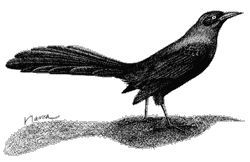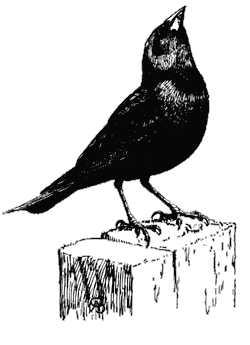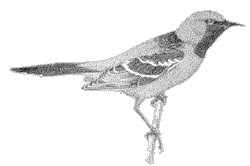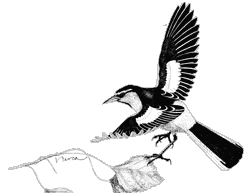Blackbirds & Orioles
The blackbird family is hard to characterize because it includes such diverse types: orioles, meadowlarks, grackles, cowbirds, and others. Most have at least some black in the plumage, and their other colors run to warmer tones, such as yellow, brown, and orange. All the species have sharply-pointed bills. Most are more or less omnivorous. None is adapted to extreme desert conditions, but several species make inroads to the Sonoran Desert.
 |
Orioles in general are treetop birds, moving methodically through the foliage in search of insects, often stopping at flowers to add some nectar to their diet. In the lowlands of the Southwest, hooded orioles and Bullock’s Orioles occur mainly as summer residents in riverside woodlands. The Hooded Oriole has a special liking for palms, however, and it may be common in desert cities where palms have been planted.
Great-tailed Grackles are recent arrivals in this region. Spreading north through Mexico, they did not reach Arizona until 1936. Even today they are closely associated with water, living near riversides, ponds, irrigated farmland, or watered lawns. Sociable birds, they nest in colonies and sleep in large communal roosts, where their cacophonous voices make them a little too conspicuous for some tastes.
Cowbirds’ nesting behavior—or lack of it—makes them the most unpopular of the blackbirds and, perhaps, the most interesting. Cowbirds lay their eggs in the nests of other birds, leaving the unwitting hosts to hatch the eggs and feed the young. In many cases, only the young cowbirds survive. Cowbirds are seldom seen in natural desert areas in winter, when they mostly forage in agricultural land; but in the breeding season, Brown-headed Cowbirds and Bronzed Cowbirds infiltrate the desert (and most other habitats), seeking nests to parasitize.
—Kenn KaufmanBlackbirds
Representative Sonoran Desert species:
Great-tailed Grackle (Quiscalus mexicanus)
Bronzed Cowbird (Molothrus aeneus)
Brown-headed Cowbird (Molothrus ater)
Order: Passeriformes
Family: Icteridae (Blackbirds and Orioles)
Spanish names: zanate, chanate (Great-tailed Grackle); tordo (Cowbird);
tordo ojirojo, tordo mantequero (Bronzed Cowbird)
Distinguishing Features
 |
Great-tailed Grackle: Very large, iridescent black plumage with a long, wide keel-shaped tail; male has yellow eyes; female is brown and much smaller. Bronzed Cowbird: Red eyes, conical beak; male: all black with a bronze iridescent sheen; female: gray-brown plumage without the sheen. Brown-headed Cowbird: Dark eyes, short, conical beak; male: brown head, black body, wings, and tail; female: grayish-brown plumage that is darker on upperparts, underparts faintly streaked, throat pale.
Habitat
All are known to occur in open to semi-open habitat including farms, fields, river groves, thickets, and city parks.
Feeding
• Diet: The grackle’s varied diet includes plant matter, insects, reptiles, small fish, aquatic invertebrates, and eggs and nestlings of other birds; the two species of cowbirds feed mostly on seeds and insects.
• Behavior: These 3 species forage mainly by walking on the ground; the grackle also forages in trees and shrubs, especially when looking for eggs or nestlings. These birds generally feed in flocks.
Life History
The Great-tailed Grackle nests in colonies; both males and females may have more than one mate. The nest site varies but is usually in dense vegetation near water. The bulky, open, cup-shaped nest, which may be a few feet to over 20 (7 m) above the ground, is made of twigs, weeds, grass, rushes, and other available material. Bluish eggs (3-5) with brown scrawls hatch in 13 to 14 days. The young, which are fed only by the female, leave the nest about 3 weeks after hatching.
Both cowbird species are brood parasites, laying their eggs in other birds’ nests where they are incubated by the host parents. In some areas this parasitic behavior has greatly diminished song bird numbers.
The Bronzed Cowbird may lay 1 pale blue-green egg per day for several weeks; the female may pierce the eggs of its host while depositing her eggs. Nestlings are fed by the host and leave the nest 10 to 12 days after hatching. Common host birds include orioles, towhees, and thrashers. Although now rather common, the Bronzed Cowbird was not recorded in Arizona until 1909.
The Brown-headed Cowbird may lay one whitish spotted egg per day for several weeks until 40 or more eggs have been laid; the female often removes the eggs of its host before depositing her own. Nestlings are fed by the host and leave the nest 10 to 11 days after hatching. Common host birds include finches, warblers, and vireos. The Brown-headed Cowbird is known to have parasitized over 200 species of birds with well over 100 species known to have successfully raised cowbird young.
Feathers
The typical feather with a shaft and vane is called a contour feather. These feathers occur on the body, the wing, and the tail. They form the outer covering of the bird providing protection from sun, wind, rain, and abrasion. The contour feathers on the wing and tail are primarily involved in promoting flight. Down feathers are frequently found underneath the body contour feathers. These feathers have a minute shaft; barbules lack hooks and flanges. The result is a very “downy”feather. Their position under the protective body contour feathers provides an air trap that facilitates heat conservation. There are several other types of feathers that have specialized functions. Semiplumes, filoplumes, bristles, and powder down are examples.
Orioles
Representative Sonoran Desert species:
Hooded Oriole (Icterus cucullatus)
Bullock’s Oriole (Icterus bullockii)
Order: Passeriformes
Family: Icteridae
Spanish names: calandria (Oriole); calandria zapotera, naranjero, bolsero
(Hooded Oriole)
Distinguishing Features
 |
Hooded Oriole: Sharply-pointed bill, two white wing bars. Male: black back, wings and tail and a large black bib from face to upper chest; orange head, belly, rump; white wing bars. Female: olive green above, olive-yellow below. The immature male looks like the female, but has a small black bib.
Bullock’s Oriole: Sharply-pointed bill. Male: black cap, nape, eyeline, back, wings, and tail; narrow black bib; orange face, underparts and and rump; white patch on wings. Female: olive-gray upperparts, dull yellow throat and chest, whitish-gray belly.
Habitat
Hooded Oriole: Open woods, tree plantations, palms, city parks, and suburbs; favors groups of palms for nesting, even when these trees are in cities.
Bullock’s Oriole: Common and widespread in the west, this species inhabits woodland, isolated groves of trees, streamside growth (especially cottonwood), farms, ranches, city parks, and suburbs.
Feeding
• Diet: Both species feed primarily on insects and take lesser quantities of fruit and nectar.
• Behavior: Both species forage by searching for insects in trees and shrubs; flowers are visited for nectar; feeders with sugar-water also attract orioles. The Hooded Oriole is a slow and deliberate forager, which makes it a rather easy bird to observe in the field.
Life History
The nest of orioles is often parasitized by cowbirds; the aggressive young cowbird usually receives the most food which eventually starves the oriole nestlings.
 |
The Hooded Oriole lays 3 to 5 bluish or grayish-white, spotted eggs in a long, hanging, woven pouch that it enters from the top. The nest usually hangs in a palm, large yucca or a eucalyptus tree. Incubation is by the female and takes 12 to 14 days; both parents feed the nestlings.
The Bullock’s Oriole lays 3 to 6 bluish-white to pale gray, spotted eggs in a hanging pouch firmly attached to a tree branch. Incubation is by the female and takes 12 to 14 days; both parents feed the nestlings.Young leave the nest about 12 to 14 days after hatching.